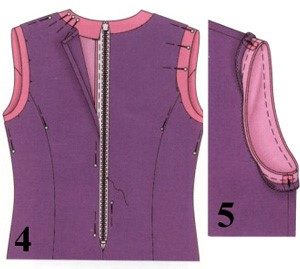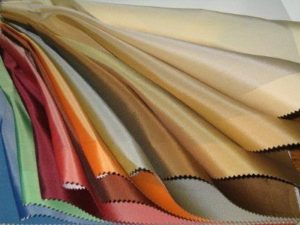 The question of using a lining is decided in each case individually. The need is determined by the cut of the main product, the thickness, texture of the fabric, even the characteristics of the owner of the future dress.
The question of using a lining is decided in each case individually. The need is determined by the cut of the main product, the thickness, texture of the fabric, even the characteristics of the owner of the future dress.
The need for a lining for a dress
 In what cases will we sew a dress with lining:
In what cases will we sew a dress with lining:
- If the fabric is loose, transparent, mesh.
- If you are planning a white dress.
- Guipure and lace necessarily require at least a partial cover.
- A cover is necessary if the main product has a complex cut with a large number of seams so that they do not rub the body.
- Natural breathable, hygroscopic, hypoallergenic lining fabrics will make life easier for people with sensitive skin and allergy sufferers.
- For girls with excessive sweating, a dress with a lining will cause less trouble.
- After all, a luxury finish requires the products to have a lining.
Rules for working with lining

There are two ways to make the lining:
- All sections are covered with it; there are no separate edgings or facings from the fabric of the main dress.
- One-piece edgings and facings are cut out from the main fabric. The lining fabric is then sewn onto them, often by hand.
 It is better to use soft, slippery fabric for the lining, then the dress will be more comfortable to wear.
It is better to use soft, slippery fabric for the lining, then the dress will be more comfortable to wear.
It is important to pre-decorate the fabric so that it does not wrinkle or shrink during wear. Only after this they begin cutting.
Raglan modeling

If you have a raglan sleeve, but for the lining we need a regular sleeve, then we perform the following operations:
- Along the shoulder seam we set aside the length of the shoulder and mark it on the pattern.
- On the sleeve pattern, place a notch in the middle of the dart, then extend the cut to the very bottom of the sleeve.
- We glue or pin the patterns of the back, as well as the shelves, to the sleeve pattern along the armhole from the very neck to the beginning of the rounding.
- We draw the contours of the new armhole.
- Cut out the pattern.
- Cut out the lining.
Advice! Before you start making the cover, make sure that the main dress is almost ready and iron it.
 Sew the lining by hand:
Sew the lining by hand:
- When cutting the cover, we minimized darts, as well as features of a complex cut, but if darts remain, sew them.
- We sew the lining parts together with machine stitching.
- We process all the allowances with an overlock stitch, or with a frequent zigzag stitch on a sewing machine.
- Iron the lining.
- Iron the seams and fold the lining.
- We process all cuts.
- We cut together the lining parts with the main dress.
- Make sure that all the main seams match, paying special attention to the armholes and neckline.
- We hide the allowances on the wrong side.
- We sew it with a blind seam by hand, paying attention to the fastener, if there is one.
Advice! If the dress has sleeves, then connect the lining sleeves in several places around the armhole, side and shoulder seams, and at the bottom of the sleeve.
Stages of work on how to sew a lining to a dress

Processing of the neckline, armholes and fasteners of a sleeveless dress.
We begin working with the cover at the stage when all that remains to be done on the main dress is the neckline and clasp.
Working with the lining:
- We do all the seams and darts.
- We process all the cuts and iron them.
- We bend the hem and stitch it.
- We sew the armholes.
- We connect the main dress with the cover face to face, matching the seams along the shoulders with the side ones.
- We process the zipper by sewing it between the lining fabric and the main fabric. To do this, turn the fabric of the cover inside out, pin the zipper to the fastening line, as well as to the neck.
- Baste, then sew the zipper into the seam, see picture.
- Fold the upper ends of the zipper so that they are between the layers of fabric.
 To fix the neckline and armholes of a sleeveless dress, we simply use the lining as a large facing, processing them simultaneously on the main fabric and on the cover. In this case, it is better to leave the shoulders and sides unsewn so that we can easily turn the resulting product inside out.
To fix the neckline and armholes of a sleeveless dress, we simply use the lining as a large facing, processing them simultaneously on the main fabric and on the cover. In this case, it is better to leave the shoulders and sides unsewn so that we can easily turn the resulting product inside out.
Processing the neckline and armholes simultaneously with the cover:
- We fold the blanks for the shelves and backs with those made from lining fabric and pin them together.
- Turn back the seam allowances.
- We sew the parts together in pairs along the armhole and neckline, leaving shoulder and side seams.
- Turn it inside out.
- We chop and then sew the front to the back along the shoulder seam.
- We sew the main parts along the shoulder seams, then the lining.
- We perform the side seams in the same way.
- We sew in a zipper, similar to the previous description. See the picture.
 A dress cover performs many functions, one of which is to give confidence to its owner, since such an outfit will not rise when walking and will not puff up.
A dress cover performs many functions, one of which is to give confidence to its owner, since such an outfit will not rise when walking and will not puff up.


 0
0





